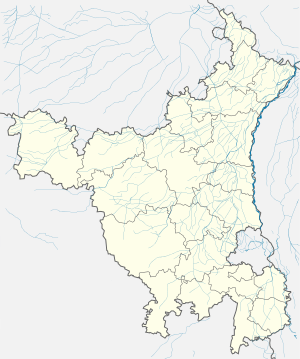Tilpat
| Tilpat Tilprastha(pandva's village) | |
|---|---|
| city | |
 Tilpat Location in Haryana, India  Tilpat Tilpat (India) | |
| Coordinates: 28°28′03″N 77°19′30″E / 28.46750°N 77.32500°ECoordinates: 28°28′03″N 77°19′30″E / 28.46750°N 77.32500°E | |
| Country |
|
| State | Haryana |
| District | Faridabad |
| Population (2001) | |
| • Total | 6,377 |
| Languages | |
| • Official | Hindi |
| Time zone | UTC+5:30 (IST) |
| Vehicle registration | HR |
| Website |
haryana |
Tilpat is a census town in Faridabad district in the Indian state of Haryana.
Demographics
As of 2001 India census,[1] Tilpat had a population of 6377. Males constitute 55% of the population and females 45%. Tilpat has an average literacy rate of 65%, higher than the national average of 59.5%: male literacy is 75%, and female literacy is 53%. In Tilpat, 18% of the population is under 6 years of age.
History
The city was originally known as 'Tilaprastha' (Sanskrit: तिलप्रस्थ, lit. sesame city).
At the time of the Mughal emperor Aurangzeb in the year 1600, Tilpat was called Tilpat Garhi. In 1669, Tilpat became the Jats revolted under Gokula, the zamindar of Tilpat. A remarkable feature of this rebellion was its composite character.[2] Though the Jats counted for its majority and provided leadership to it, it consisted of other local people as well such as, Mev, Meena, Ahir, Gujar, Naruka, Panwar and others.[3] The rebels gathered at the village of Sahora (about 6 miles from Mathura). Abdun Nabi, the faujdar of Mathura, attacked them. At first he appeared to be gaining ground, but in the middle of the fighting he was killed on 12 May 1669 (21st Zil-Hijja, 1079 A.H.),.after then he call tilpat and surdas mandir for surdas and radhey shayam[4][5][6] Fighting continued for three days in which muskets and bows were used by the contestants. On the fourth day, the royalists charged the besieged from all sides and having made a breach in the walls entered Tilpat.[7][8]
References
- ↑ "Census of India 2001: Data from the 2001 Census, including cities, villages and towns (Provisional)". Census Commission of India. Archived from the original on 2004-06-16. Retrieved 2008-11-01.
- ↑ Girish Chandra Dwivedi, The Jats – Their role in the Mughal empire, Ed by Dr Vir Singh. Delhi, 2003, p. 25
- ↑ Ganga Singh, op. cit., I, p. 64-65
- ↑ Maasir, p. 83
- ↑ Roznamcha also known as Ibratnama by Muhammad (R.S.L. Ms p. 133)
- ↑ Dwivedi, Prasad, Girish Chandra, Ishwari (1989). The Jats, their role in the Mughal Empire, Quoting Maasir, p. 83; Roznamcha, also known as Ibrat Nama by Mirza Muhammad, p. 133; Kamwar (pers. Ms.). Arnold Publishers. p. 27. ISBN 8170311500.
- ↑ Sharma, Gautam (1990). Valour and Sacrifice: Famous Regiments of the Indian Army. Allied Publishers. pp. 152–153. ISBN 9788170231400. Retrieved 19 November 2015.
- ↑ Awrangābādī, Shāhnavāz, Prashad, Shāhnavāz Khān, ʻAbd al-Ḥayy ibn, Baini. The Maāt̲h̲ir-ul-umarā: being biographies of the Muhammadan and Hindu officers of the Timurid sovereigns of India from 1500 to about 1780 A.D. (1 ed.). Asiatic Society, 1979; Low Price Publications, 1999. p. 437. ISBN 9788175361591. Retrieved 30 Jul 2008.